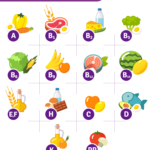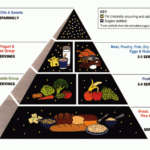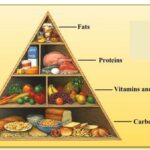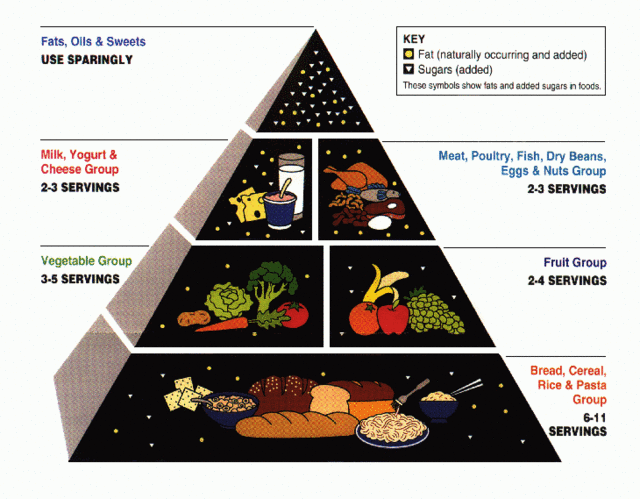Write About the Different Food Groups and Their Functions
Many youth will already have knowledge about the different Food Groups and why a variety of foods from those groups is needed by their body. This could be knowledge they have received from their family members or from their school experiences.
Display your Food Guide poster and ask everyone to find a place where they can see it clearly. Then divide them into 4 groups and give each group a Food Group card.
Vegetables
Vegetables are a group of foods that provide important vitamins, minerals, and dietary fibre. They are also low in calories and a key part of a healthy eating pattern.
Vegetable nutrients are found in their leaves, stalks, roots, bulbs, seeds, and flowers. They are a good source of fibre and phytonutrients, which have antioxidant properties. They are an important part of a balanced diet and should be included at every meal.
Many vegetables are also considered fruits by botanists. Examples include tomatoes, avocados, eggplants, and squashes. They are usually sweet in taste and have a fleshy consistency. However, for nutritional purposes, they are included in the Vegetable Group along with other vegetables like broccoli and green beans.
The Vegetable Group includes dark green vegetables, red and orange vegetables, starchy vegetables, and legumes (beans and peas). This group contains a variety of colours, flavours, and textures, and offers different vitamins, minerals, and dietary fibre. The table below lists specific amounts of vegetables that count as 1 cup-equivalent of vegetables (in some cases, equivalents for 1/2 cup are shown).
Fruits
For many of us, the difference between fruits and vegetables may seem obvious — if it’s sweet and juicy like an apple or strawberry, it must be fruit. But from a botanical perspective, the distinction is more complex. A fruit is the seed-bearing part of a flowering plant, and it’s through fruits that plants disseminate their seeds. Fruits develop from the inferior ovary of a flower, and their fleshy appearance comes from floral parts such as petals, sepals, stamens and styles that fuse with or fall off the ovary as it ripens. Fruits also come in a variety of sizes and shapes, depending on the plant and the kind of seed.
A number of animals — from mice and kangaroo rats to elephants — act as seed dispersers by eating fruits and spreading the seeds inside them. In the tropics, bats (for example, the flying fox, Pteropus) are also important dispersers of fruits and their diaspores. In fact, fruits that are well adapted for bat consumption often have long, narrow, fleshy bodies with large seeds and rank, aromatic odours.
Dairy
Dairy foods, like milk, cheese and yogurt, are important for health throughout the life cycle. They are a good source of calcium, potassium, vitamin D and protein.
Traditionally, many dairy foods are seen as indulgent snacks or treats but in actuality they can be part of a healthy diet, when eaten in moderation. For example, whole milk and cream cheese can offer a good source of protein and calcium while low-fat and non-fat milk and yogurt provide more heart-healthy options.
Foods in the dairy group also include curd, butter, ice cream and yogurt. However, products made from plant-based milk (e.g. soy milk) do not belong to this group.
Milk and dairy foods are widely available and affordable and provide a number of key nutrients important for health across the lifespan, including calcium, potassium, protein and vitamin D. However, some people avoid dairy foods due to intolerances or for other reasons such as veganism. Visit IDFA’s online dairy resource center, #DairyNourishes, to learn more about dairy’s positive impact on health and wellness at every age and stage of life.
Meat
The proteins in meat, from animals (usually domesticated cows, pigs and sheep), are important for our bodies because they have all the essential amino acids. Meat also provides us with fat, which helps to give our bodies energy. Meat is a good source of vitamins B (especially vitamin B6), C, E and K, as well as iron.
To help everyone understand why a variety of foods from the 4 Food Groups are needed by our bodies, display your Workpad poster and ask participants to sit where they can all see it clearly. Tell them that they will build on what they already know about the functions of different foods by dividing themselves into groups of 4. Give each group one of the Food Group cards that were made for the previous Activity.
Let each group find a quiet place where the other groups can’t hear them. Then let someone from each group tell the others about the function of the Food Group that they have been assigned to. Each person should speak for about 5 minutes.
Fats & Oils
Fats and oils are important nutrients in a healthy eating pattern. They supply calories for energy, help the body absorb fat-soluble vitamins and aid in hormone production. Foods containing fats and oils include both plant foods like nuts, olives and some fish, as well as animal foods like butter, lard, shortening and mayonnaise. Oils are fats that are liquid at room temperature, such as vegetable oils used in cooking. Foods containing primarily oils are salad dressings and soft margarine that come in tubs or squeeze bottles.
Chemically, fats and oils are esters of glycerol with three fatty acids attached. They are also known as triacylglycerols or triglycerides. Fats and oils are a subset of a group of nutrients called lipids, which also includes phospholipids and sterols. Lipids are distinguished from other foods by their melting points and structure, which can be characterized as either saturated or unsaturated. Unsaturated lipids are divided further into mono- and polyunsaturated fatty acids. The function of lipids in the diet depends on the type and proportion of fatty acids they contain.







